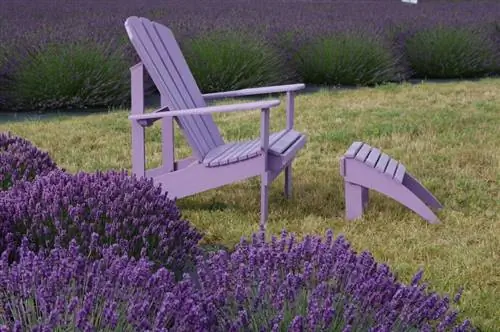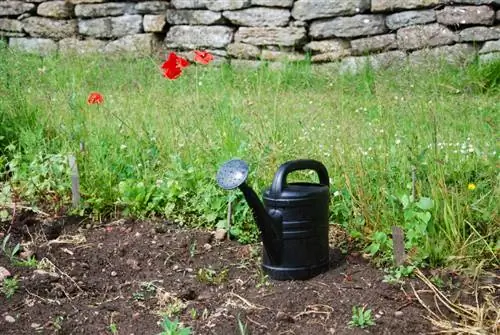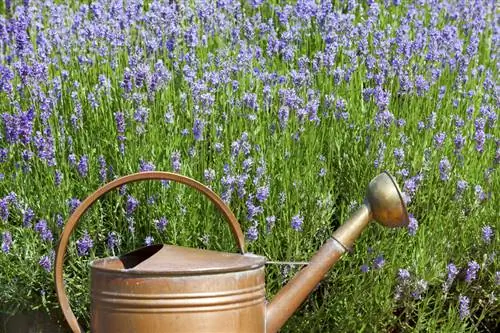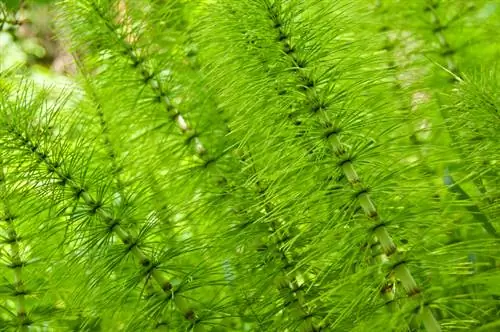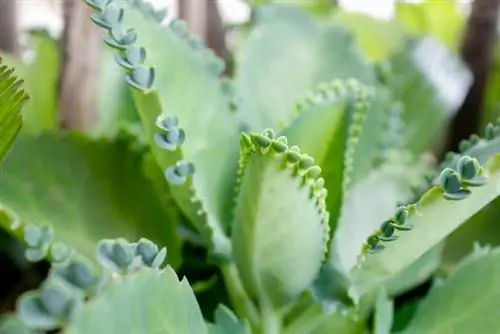- Author admin [email protected].
- Public 2023-12-16 16:46.
- Last modified 2025-01-23 11:20.
Lavender is a real all-round talent: thanks to the long flowering time and the lush, mostly blue or violet flowers, the plant is an eye-catcher in every garden. At the same time, flowers and leaves can be used in many different ways in the kitchen and in the household. Lavender care is relatively simple, as the plant is easy to keep happy with plenty of sun and a warm, dry spot. It just can't tolerate wetness and cold. With good care, lavender can live between 20 and 30 years.
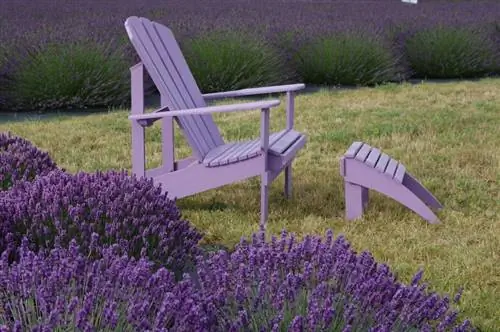
How do I care for lavender properly?
To properly care for lavender, the plant needs a lot of sun, dryness and protection from moisture. Only water when the soil is dry and avoid waterlogging. Fertilizing is only necessary annually with potash fertilizer, stable manure (€56.00 on Amazon) or compost. Cut back the lavender in spring and summer.
When and how often do I have to water lavender?
How do I care for lavender? This question is often asked, as it is a Mediterranean, heat-loving plant. But don't worry: caring for lavender properly is actually not difficult. This means that the plant - after all, it comes from the dry areas of the Mediterranean - should be protected from moisture and moisture. Waterlogging in particular has a damaging effect on their growth; the roots can also rot and other parts of the plant can become moldy. You only need to water garden lavender when the soil is dry - although it does not harm the plant if the soil occasionally dries out completely for a short period of time. Also be careful not to give the plant too much water at once. Lavender develops very deep taproots that can draw water from deeper layers of the earth. Only potted lavender should be watered more frequently, although the substrate should only be kept moist, but never wet. It is best to water early in the morning and avoid wetting leaves and flowers.
Does lavender need fertilizer and if so, which one?
Many gardening guides say that lavender should be fertilized every two weeks. However, fertilizer is hardly necessary when caring for lavender - especially not in such short intervals - since the plant comes from a region with traditionally nutrient-poor soils. Therefore, frequent fertilizer applications do more harm than good and tend to encourage the plant to become bald. In principle, it is sufficient to provide lavender with potash fertilizer, manure (€56.00 on Amazon) or compost once a year, ideally at the beginning of the growing season in spring. If possible, avoid using a nitrogen-rich fertilizer (such as horn shavings), as this primarily stimulates the plant's irregular height growth.
Is it useful to mulch lavender?
No, you should avoid mulching with bark mulch, peat or sawdust. The mulching material also stores moisture, which in turn promotes the formation of mold on lavender. This also acidifies the soil, which the lavender also cannot tolerate. A layer of sand or pebbles is more suitable, as it provides additional warmth and also keeps the plant nice and dry.
What do I have to consider when caring for potted lavender?
The roots of lavender require a lot of space, which is why you should choose a pot that is as deep and wide as possible. The more freely the roots can spread, the longer the plant will thrive. It is also important to avoid waterlogging through good drainage. For this purpose, layer several centimeters of expanded clay or small pebbles at the bottom of the pot, then excess irrigation water can drain away unhindered. The trivet must not be filled with water; it is best to remove this regularly.
Which species are particularly suitable for keeping in a bucket?
In particular, the distinctive but sensitive crested lavender is ideal for keeping in a pot.
I only have a small garden, which variety is suitable for this?
Some lavender varieties can grow quite tall, some even up to a meter, so small gardens can quickly become overgrown. Therefore, small, compact lavender varieties are best suited for this, such as 'Dwarf blue', which only grows to a height of 30 to 40 centimeters. By the way, this variety is winter hardy.
How often do I have to repot lavender?
Poted lavender should be repotted once a year - ideally in spring, at the beginning of the growing season. If you have just purchased potted plants from a gardener or garden center, plant them in a sufficiently large pot as soon as possible. In the usually small plant pots, the sensitive roots are too crowded, which severely impairs the growth and he alth of the lavender.
How big does the pot have to be?
Choose a pot with at least 10 liters capacity. The ideal lavender pot should not be shallow (i.e. no balcony box or similar), but should be as deep as possible because of the taproot.
Can I also keep lavender as a houseplant?
Lavender is only partially suitable as a houseplant, like so many Mediterranean plants. Properly caring for indoor lavender is not an easy task because you should imitate the natural living conditions as best as possible. This also includes placing the plant on the balcony in summer if possible and ensuring that it stays cool but frost-free in winter. Keeping it in the (heated) living room all year round will most likely cause the lavender to die.
When and how should you cut lavender?
The fast-growing lavender should at best be cut back twice a year, once in spring and a second time at the end of the flowering period in summer. Cut the plant back by about half, but without cutting too much into the old wood - the lavender cannot tolerate this and will not sprout again in the cut area.
What pests can occur on lavender and what remedies are there against them?
Lavender has a high proportion of essential oils, which usually keeps pests away. It is not without reason that scented sachets with dried lavender flowers are a popular remedy for moths in the wardrobe. By the way, snails are also extremely reluctant to eat lavender.
Can I also grow lavender as a lavender tree?
Lavender is actually a so-called subshrub, not a tree. However, since the older (lower) parts of the plant become woody over time, a lavender standard can be grown with a little effort. However, to keep its shape, it needs to be trimmed regularly.
Can I also harvest from the lavender tree?
Of course you can harvest from your lavender tree just like you would from any other lavender.
Can I overwinter lavender in the garden?
Only certain frost-hardy lavender varieties are suitable for overwintering outdoors. Some varieties, on the other hand, should only be cultivated in pots (such as the popular lavender), as they cannot tolerate frost and freeze to death. It is best to cover hardy lavender varieties with brushwood in winter to prevent the plants from drying out. In the case of prolonged, very frosty temperatures, additional protective measures such as covering with a coconut mat are recommended.
What is the best way to overwinter lavender in a pot?
Potted lavender should never overwinter outdoors, but in a cool but frost-free place. Temperatures around 10 to 12 °C are best suited for this - for example a stairwell or the (unheated) bedroom.
Which varieties are particularly resistant to frost?
The only species that is really considered hardy is the so-called real lavender (Lavandula angustifolia), with the established varieties 'Hidcote Blue' or 'Munstead' in particular being extremely robust.
Tips & Tricks
Although lavender should be watered sparingly, the plant needs more water in very hot summer temperatures - then you can water it every day. Just make sure your lavender isn't wet!

